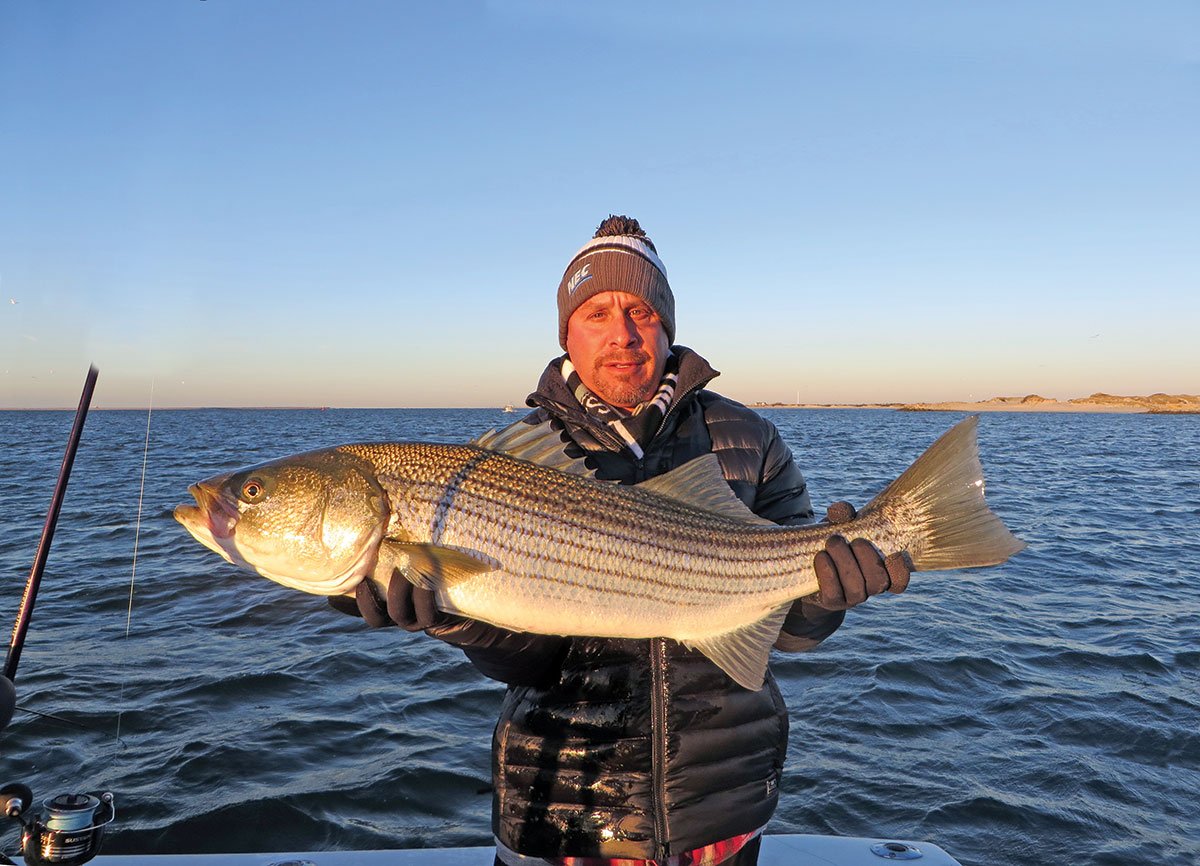
The ultimate reward in fishing a surface plug is when a 30 or better striper rises from the depths to crash your offering, setting off a shower of spray and some wild surface antics.
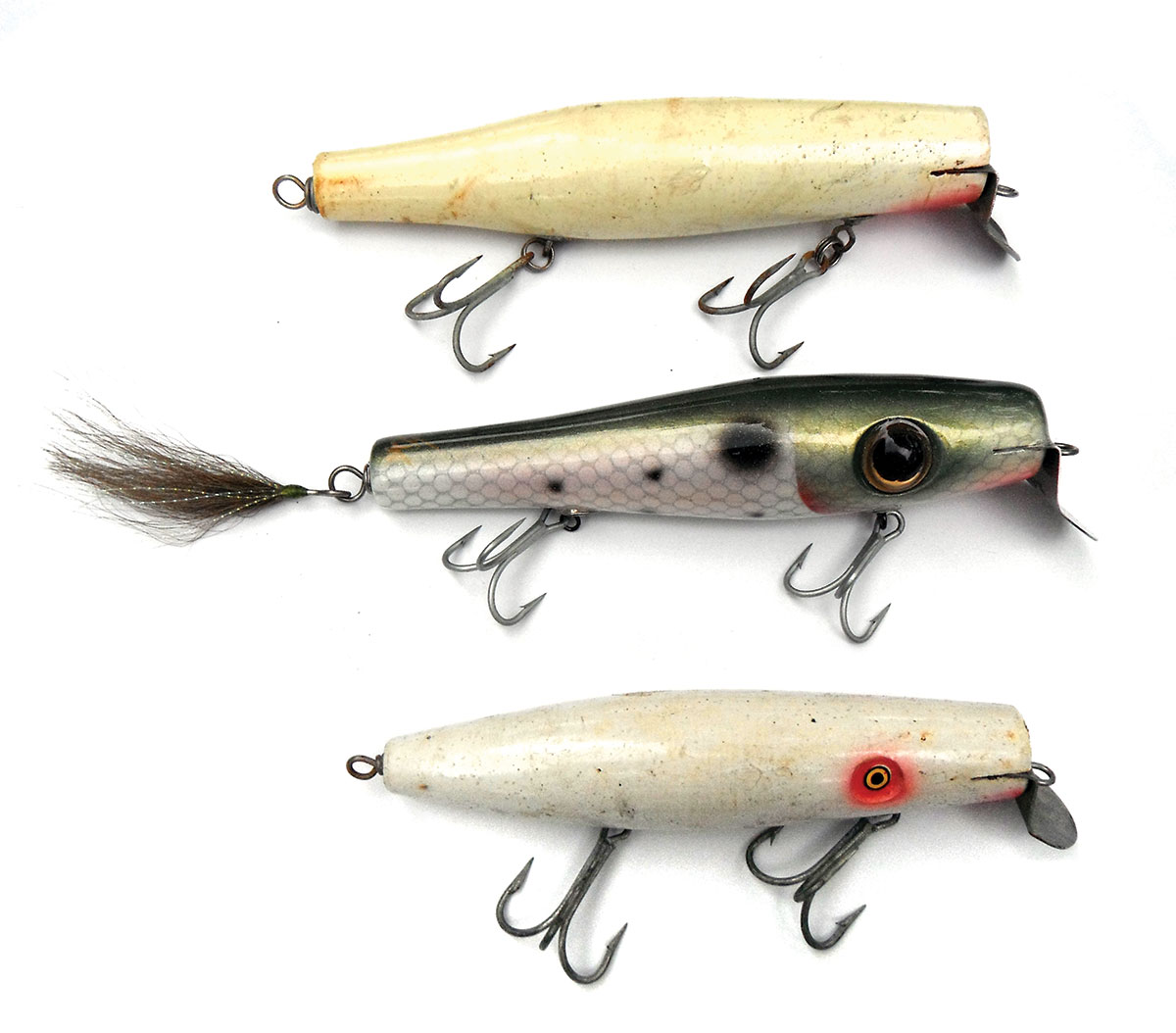
One of the most appealing aspects of striper fishing for many anglers is the diversity in techniques that can be applied when targeting them. Bait fishermen can choose from a wide range of offerings including, sea worms, clams, crabs, squid, bunker, mackerel, herring, sand eels and a host of other baits. Sharpies who rely on live bait drift bunker, eels, porgies, spot, herring, shad, bergalls, mackerel and legal flounder. If trolling is your cup of tea, you can tow bunker spoons, Mojo rigs, umbrella rigs, parachute jigs, plugs or tubes. When it comes to just putting fish in the boat, there’s always clam chumming to stir up some action.
For those who like to cast, the options are equally diverse. While there is nothing like having a big striper come up and crash a topwater plug, there are times when bass will shun a surface lure but readily strike a deep running bucktail or a soft plastic being worked through the water column. In either case, casting is the most interactive of all the methods, and also offers the greatest challenge. Matching the hatch, selecting the right color or pattern, and figuring out the right retrieve on any given day are all part of the casting game.
Casting opportunities abound up and down the Striper Coast. As with any form of striper fishing, structure is often the key to success. In most cases, you will be working shoreline areas featuring drop-offs, points, boulders, jetties and anywhere rips form. There are also times during the season when stripers will be found in open ocean waters gorging on schools of bunker or other baitfish, especially during the spring or fall migrations.
The Lighter Side
Tackle can range from the lightest spinning outfit for tossing 1/2-ounce bucktails or soft plastics to 8- and 9-footers capable of lobbing 3-ounce hunks of wood or plastic.
The large numbers of small stripers currently in the fishery make perfect targets for light tackle anglers casting plugs, soft plastics and bucktails. These fish are aggressive and can provide lights out action once you locate a body of fish. I make it a point to always carry what some anglers would consider too light a spinning rod for work on the salt chuck, but nothing could further from the truth. My 6-foot medium/light rod matched to a 2500 series spinning reel spooled with 10-pound braid is the perfect tool for bucktailing schoolies, but bass to 35 pounds have succumbed to this outfit as well.
Keep a selection of 1/2- to 1-ounce bucktails and leadheads for soft plastics at the ready, along with some swimming plugs and poppers in the 3/4- to 1-1/4-ounce range to cover any schoolie action that might pop up. And don’t overlook the effectiveness of smaller lures, especially bucktails, on much larger fish. When the fish are feeding on small bait such as bay anchovies, you will be glad you have the light tackle along.
Beefing It Up
For casting situations where you are likely to encounter bigger fish, and will be delivering larger payloads, you’ll need to step up to outfits capable of throwing larger swim baits and plugs. Rods from 7 to 9 feet and reels in the 4000- to 4500-size range spooled with 20-pound braid come into play here.
Bars that form near the mouths of inlets and breachways, and the white water created by waves breaking over the bars that often build up around these openings, offer casters a prime opportunity for casting action. A word of caution is required when it comes to working the white water at the mouths of inlets and breachways. Only experienced boatmen should attempt to fish these areas since one little mistake can easily result in an overturned boat. Before making a cast, study the location of breaking waves and try to position the boat in the calm water adjacent to the bar but within casting distance of the white water. Always keep your engine running and have someone at the wheel in case a rogue wave – not an uncommon occurrence – comes along.
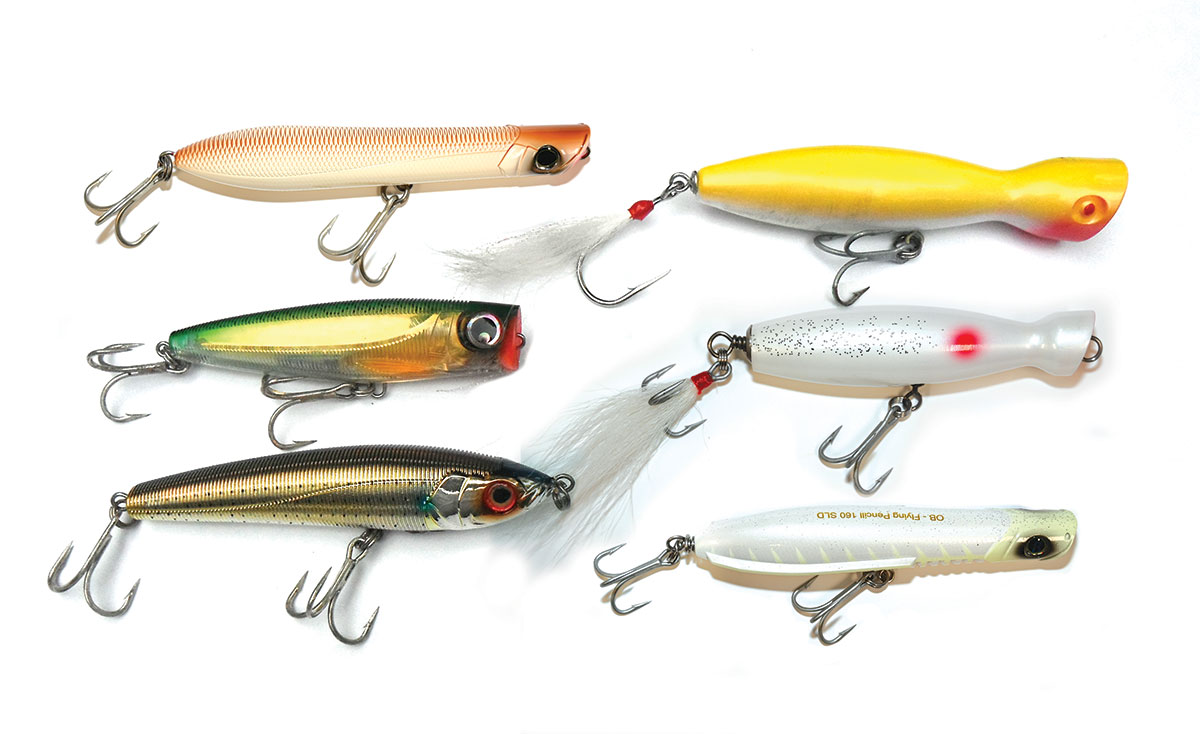
This is a situation where casting distance can be a factor so your tackle should reflect that need. A 9-foot rod may be cumbersome on a boat, but it will allow for longer casts. I’ve always favored a casting outfit for tossing metal lip swimming plugs like the large Danny, but where distance is critical, spinning is a better option, especially when dealing with situations where you may be casting into a wind. Although metal lips can be very effective when cast on the backsides of breaking waves, little neck style poppers or pencil poppers will provide much more distance and are also easier to work in the white water.
When it comes to working boulder strewn shorelines, or calm back-bay shorelines, I love to throw large metal lip swimmers. Back in my teenage years, I would spend time during my summers staying at Al & Mary’s Hotel in Montauk. Al was Al Urban, a legendary captain and striper guide who specialized in casting large metal lipped surface plugs shoreward into Montauk’s boulder strewn south side. I would cut the grass and tend to flower beds in exchange for Al taking me along on his afternoon jaunts down the south side. It was that early introduction to plug fishing that led to my own love for fishing topwater plugs whenever the opportunity presented itself. It may not be the most productive approach to the striper game at times, but having a 20- or 30-pound striper explode on a topwater plug is tough to beat. For those who take the time to learn how to work the various topwater offerings, the rewards are worth the effort.
Standard popping plugs, pencil poppers and metal lip swimmers make up the bulk of the topwater options. Traditionally, most surface plugs are considered daytime tools, but there are times when these lures can be extremely effective after dark. The only negative to working them at night is you lose the benefit of witnessing what is often a dramatic surface strike.
Montauk’s boulder studded south side is prime turf for casting topwater plugs shoreward. Similar opportunities are found around Plum Island, Fishers Island, Block Island and Cuttyhunk. New Jersey may lack boulder studded shorelines, but there are plenty of jetties that casters can take advantage of. Calm seas are Ideal for fishing these locations, but for those times when there is a heave on the ocean, make sure you stay beyond the outermost break.
Topwater Arsenal
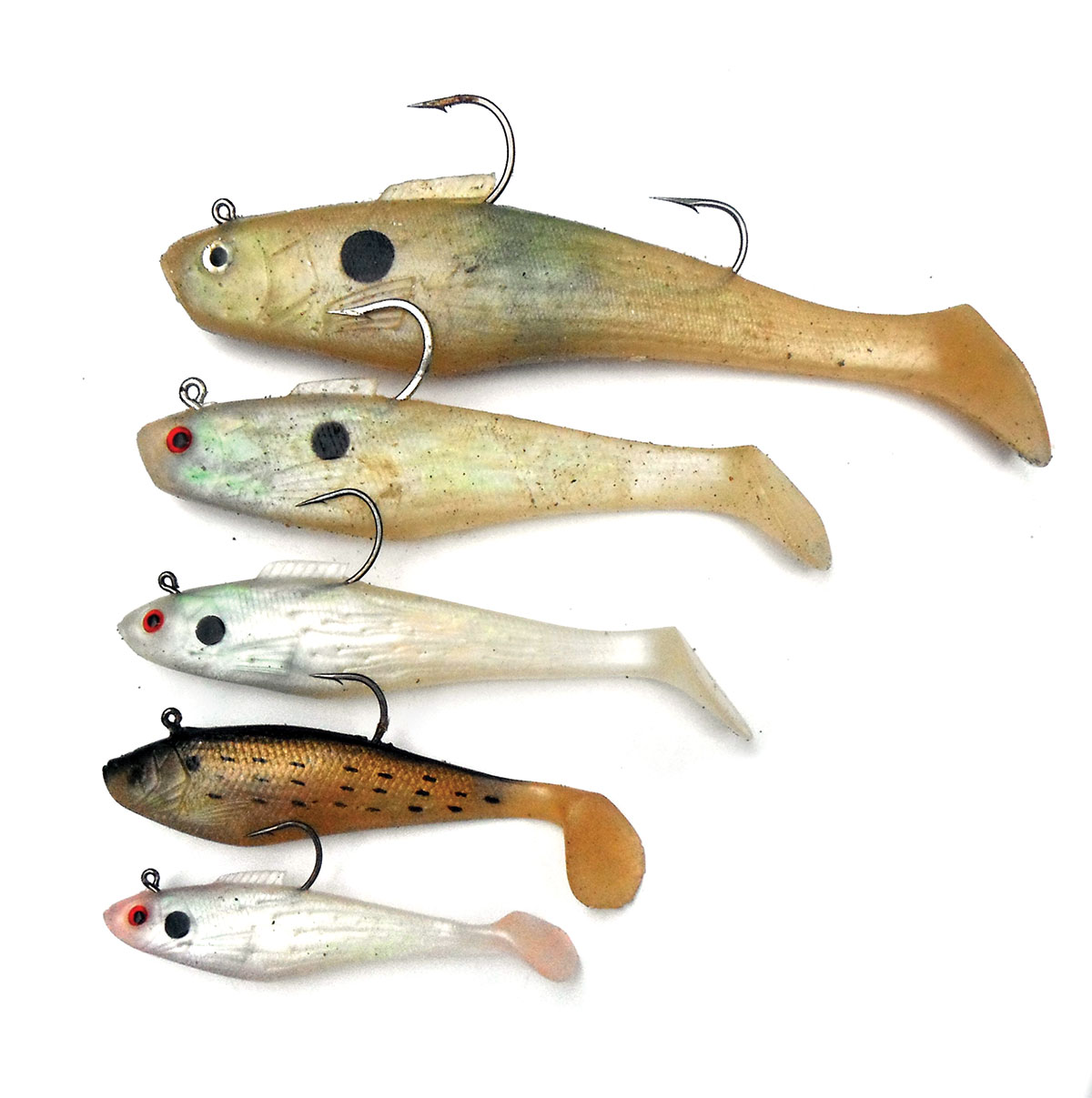
Standard poppers, those with a concave head, are a must. For the most part, stripers are lazy and do not like to expend a lot of energy chasing down a meal. This is especially true of big bass. The trick to working a popper slowly on the surface lies in getting to know your plugs and developing a rhythm. Plugs that float are obviously much easier to work on the surface, while some sinking plugs require considerable effort to keep them on top. You should not have to jerk hard to make a plug “pop.” Moving your wrist and forearm a half foot or so is all it should take under most calm water conditions. Some of these plugs like the 2-3/8-ounce Super Strike Little Neck Popper or the Ocean Born Little Neck can be made to swim on the surface with an action similar to a Danny style swimmer.
Pencil poppers have the ability to draw explosive strikes and raise bass when other surface plugs cannot. Pumping the rod will cause the head of the plug to slap up and down and side to side in a motion that fish find hard to ignore. Another virtue of these plugs is their castability. When they are balanced properly, they are among the best plugs for long distance delivery. For boatmen, that can mean keeping a safe distance from rocky outcroppings and the white water of inlet bars and still being able to put your plug in the strike zone.
Metal lip swimmers, aka Danny Style swimming plugs, are my favorites when conditions are right. When worked properly, that seductive, tantalizing side to side wiggle can drive stripers wild. The Gibb’s Danny is the most readily available, while some custom made versions such as those made by Beachmaster are available in limited numbers and sell out as soon as they hit tackle shop shelves. The 6- to 8-inch models are a good match when stripers are feeding on bunker, herring, shad, mackerel, small bluefish and a host of other large baitfish. Adjusting the plug to swim on the surface is accomplished by using a pair of pliers to bend the eye of the plug in the opposite direction you want it to swim. Bend it down to make it swim higher on the surface, and up to make it swim below the surface.
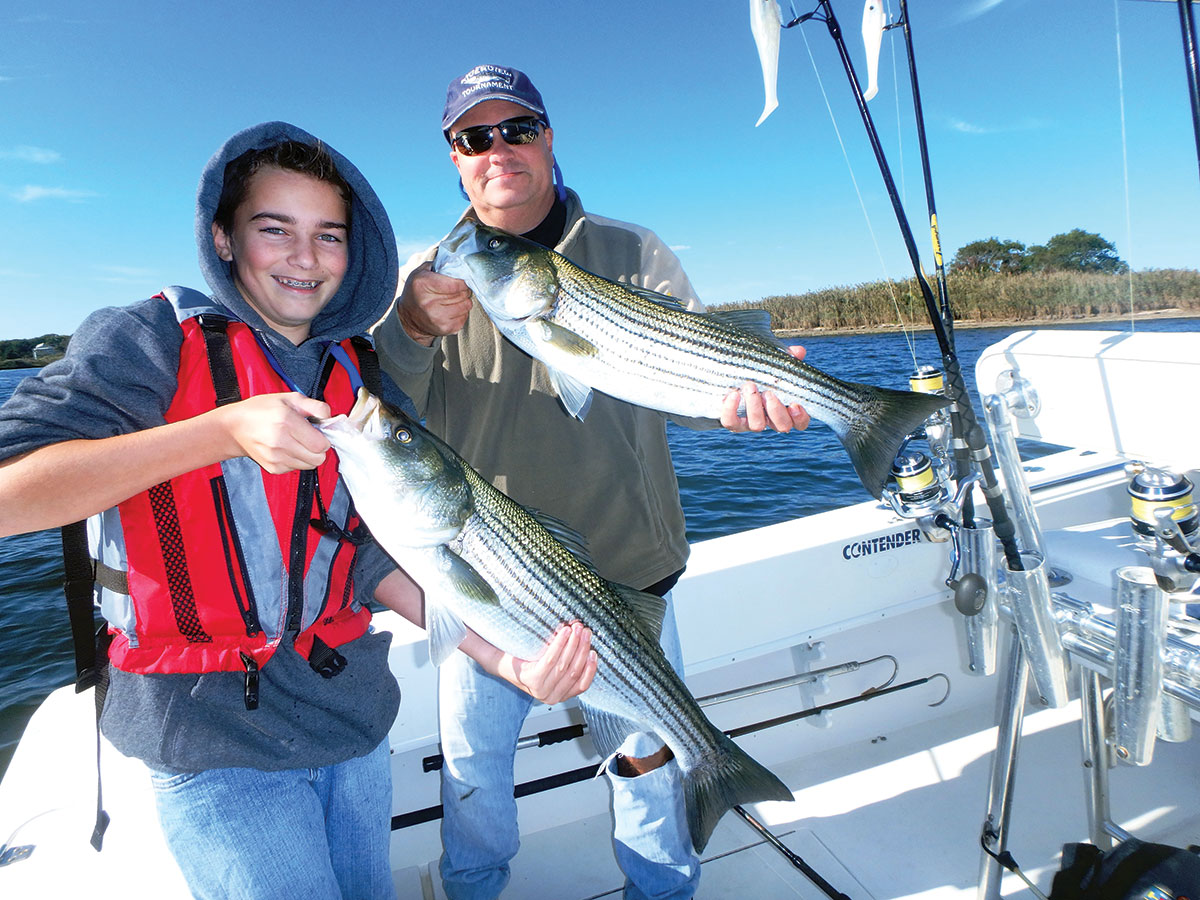
Getting Down
There are plenty of times when bass will do the bulk of their feeding well below the surface and will refuse any surface offerings. The abundance of bunker along the Striper Coast over the last decade has made carrying weighted swim shads a must. Whether you are trying to match peanut size bunker or adult bunker, there is a size that fits the bill. These are one of those “idiot proof” lures that requires little finesse to be effective. A basic steady retrieve will often draw strikes with these lures. I like to carry an assortment of sizes from 3 to 6 or 7 inches in the bunker and pearl white finishes produced by Tsunami.
I don’t go anywhere without bucktails. Their versatility and ability to get down when stripers are hugging the bottom makes them a must have item in your casting arsenal. A selection of weights from 1/2 to 3 ounces should cover most situations you are likely to come across. Most of my fishing is done with leadheads ranging from 3/4 to 1-1/2 ounces. If I had to pick one color it would be white, but my all-time favorite is the bay anchovy pattern turned out by Premium Bucktails.
Casting for bass from the deck of a boat has grown in popularity by leaps and bounds as more and more anglers have discovered the challenge and effectiveness of this approach. Now is a great time to get in the game as fall winds become more prevalent, and stripers feed up for the fall migration.



